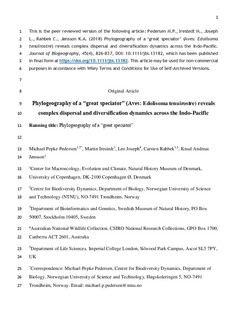| dc.contributor.author | Pedersen, Michael Pepke | |
| dc.contributor.author | Irestedt, Martin | |
| dc.contributor.author | Joseph, Leo | |
| dc.contributor.author | Rahbek, Carsten | |
| dc.contributor.author | Jønsson, Knud A | |
| dc.date.accessioned | 2019-04-09T06:24:18Z | |
| dc.date.available | 2019-04-09T06:24:18Z | |
| dc.date.created | 2018-02-07T20:29:32Z | |
| dc.date.issued | 2018 | |
| dc.identifier.citation | Journal of Biogeography. 2018, 45 (4), 826-837. | nb_NO |
| dc.identifier.issn | 0305-0270 | |
| dc.identifier.uri | http://hdl.handle.net/11250/2593769 | |
| dc.description.abstract | Aim: We derive a new phylogenetic framework of the Indo-Pacific avian genus Edolisoma based on a dense taxon sampling and use it in an explicit spatiotemporal framework to understand the history of intraspecific diversification dynamics in a ‘great speciator’, the Cicadabird Edolisoma tenuirostre/remotum complex. Location The Indo-Pacific island region, Australia and New Guinea. Taxon: Corvoid passerine birds (Passeriformes). Methods: We used Bayesian phylogenetic methods (beast) to construct a time-calibrated molecular phylogeny of all 19 species in the genus Edolisoma and 27 of 29 subspecies of the E. tenuirostre/remotum complex (previously Coracina tenuirostris) primarily based on one mitochondrial DNA marker. Ancestral area reconstruction methods (‘BioGeoBEARS’) were used to infer the historical biogeography of the genus. We used population-level analyses to assess intraspecific phylogeography and a molecular species delimitation test to evaluate the current taxonomy. A morphometric dataset was used to discuss differential dispersal ability among taxa. Results: Edolisoma originated in the late Miocene and diversification within the E. tenuirostre/remotum complex began in the Pleistocene. Within the North Melanesian and North Wallacean archipelagos, which have experienced several waves of diversification, we find significant patterns of genetic isolation by distance, but not within the Australo-Papuan ‘mainland’, which was recently back-colonized from these archipelagos. Based on the phylogeny, we suggest several taxonomic changes. We also discuss evidence of taxon cycles within Edolisoma based on correlations of species age, elevational ranges and dispersal ability. Main conclusions: The biogeographical history and patterns of differentiation between phylogroups within E. tenuirostre support the importance of barriers to gene flow in island systems. Examples of both recent genetic exchange across significant sea barriers and differentiation across much smaller water gaps suggest complex dispersal and diversification dynamics. The capacity for dispersal away from islands, and gradual shifts in dispersal ability in relation to the geographical setting, is supported as important factors in generating a ‘great speciator’. | nb_NO |
| dc.description.abstract | Phylogeography of a ‘great speciator’ (Aves: Edolisoma tenuirostre) reveals complex dispersal and diversification dynamics across the Indo-Pacific | nb_NO |
| dc.language.iso | eng | nb_NO |
| dc.publisher | Wiley | nb_NO |
| dc.relation.uri | https://doi.org/10.1111/jbi.13182 | |
| dc.title | Phylogeography of a ‘great speciator’ (Aves: Edolisoma tenuirostre) reveals complex dispersal and diversification dynamics across the Indo-Pacific | nb_NO |
| dc.type | Journal article | nb_NO |
| dc.type | Peer reviewed | nb_NO |
| dc.description.version | acceptedVersion | nb_NO |
| dc.source.pagenumber | 826-837 | nb_NO |
| dc.source.volume | 45 | nb_NO |
| dc.source.journal | Journal of Biogeography | nb_NO |
| dc.source.issue | 4 | nb_NO |
| dc.identifier.doi | 10.1111/jbi.13182 | |
| dc.identifier.cristin | 1563010 | |
| dc.description.localcode | Locked until 7 February 2019 due to copyright restrictions. This is the peer reviewed version of an article, which has been published in final form at https://doi.org/10.1111/jbi.13182. This article may be used for non-commercial purposes in accordance with Wiley Terms and Conditions for Self-Archiving | nb_NO |
| cristin.unitcode | 194,66,10,0 | |
| cristin.unitname | Institutt for biologi | |
| cristin.ispublished | true | |
| cristin.fulltext | postprint | |
| cristin.qualitycode | 2 | |
